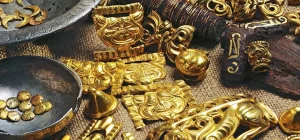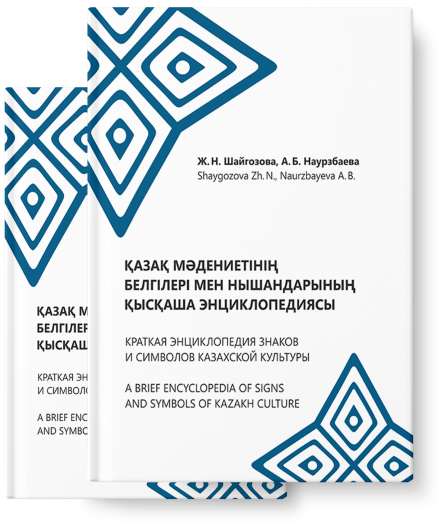
A short encyclopedia of
Signs and symbols of
Kazakh culture

The symbolism of gold in world culture is manifold: in Christianity it is a symbol of heavenly light and holy peace, in Greek and Roman mythology the “golden age” is called the best time. Gold has long been considered by people as the solar metal, the element of air and the masculine.
In the Sak era, gold becomes an equivalent of artistic expression of the idea of the sacral realm of the sun, because the sun is the king according to ancient beliefs. This is evidenced by numerous archaeological artefacts of the Sak menagerie from chieftain’s tombs discovered throughout Kazakhstan (Issyk, Berel, Taldy and many others). The ancient nomads believed that direct contact with gold (gold jewellery on clothing) connected them with the power of the sun, divine energy and immortality. In the tripartite structure of the world, gold is the marker for the highest, and in the horizontal projection it represents the east and the sunrise.
Gold stood for pure, spiritual energy. All objects and attributes had to be either made entirely of gold or at least decorated with it. Animal-style gold was not only a valuable artistic material, but embodied the philosophical and aesthetic attitudes of Indo-Iranian and Indo-European cultural traditions. As a sacred metal, gold embodied a materialised mythic consciousness, the key concept of which was the idea of immortality (which later actively manifested itself in the Turkic tradition as well). The concept of “gold” like any other “metal” in the Turkic mythopoetics, fulfilled a universal classificatory function and symbolised basic cosmic zones and their inhabitants, starting from the sun sign. Therefore, gold symbolised the highest social status, power and wealth, and was also a distinguishing mark in the clothing of the Genghisids (descended from Genghis Khan). Khans, sultans and other nobles wore clothes embroidered with gold during special festivities since the time of the Golden Horde. Experts believe that the extensive cultural relations of the Golden Horde made it possible to develop the art of gold thread embroidery in the territory of Ulus Jochi in the 13th and 14th centuries, which later became a kind of calling card of the Kazakh elite. The respectful attitude of Kazakhs towards gold has survived to this day and is reflected in the tradition of naming children: Altyn, Altynshash, Altynai, Altyngul, Altynbek, Altynkhan, etc. In the tradition of exchanging gifts at wedding ceremonies, gold has long retained its most important value.
The sacred nature of gold is expressed in the expressions: “sabyrdyn tübi sary altyn”, “altyn uya”, “altyn orda”, “altyn söz”, etc.
It is noteworthy that the Kazakh word “zerger – jeweller” comes from the Persian “zer-zar”, which means “gold”.

